SEIKO MIKAMI
PEOPLEText: Mariko Takei
Seiko Mikami is an artist operating on the forefront of the international media art scene. She has been showing several large-scale installations dealing with the human body and the information war since the 1980s. The first comprehensive exhibition in Asia introducing her works, “Desire of Codes” is exhibited at Yamaguchi Center for Arts and Media [YCAM], starting March 20. What will be revealed in this interactive installation work which surveys the audience? SHIFT interviewed the artist to discuss about her new work based on desire growing in information systems.
Please introduce yourself including your past activities.
Seiko Mikami, artist and professor at Tama Art University. Showing installations with themes on “information society and the human body” since 1984, I set myself to be based in New York in the 90’s, exhibiting works in galleries and art museums mainly in the US and Europe. It was 1991 when my first audience-participatory interactive art piece “Pulse BEATS” was unveiled at P3 Art & Environment. Later, I made various media art installations incorporating human perception including the eye tracking project “molecular Informatics” (Canon ARTLAB, 1996), acoustic sense and an inner body sound piece (ICC’s permanent correction, 1997), tactile 3D perception piece (New York, 1998), and “gravicells” on the theme of gravity called the 6th consciousness (YCAM 204).
“Desire of Codes” was exhibited at Kulturhuset (Stockholm Sweden, 2005-2006), and later went on a tour to Germany in 2007, England in 2008, and France in 2008. For this exhibition at YCAM, the latest version is showcased with 2 additional new pieces. Of those, 2 pieces will be exhibited at RUHR ISEA in Dortmund of European Capital of Culture from July 30 to September 5, 2010, while another piece will be exhibited at Künstlerhaus in Wien from August 8 to September 20, and then will go on a tour to Europe.
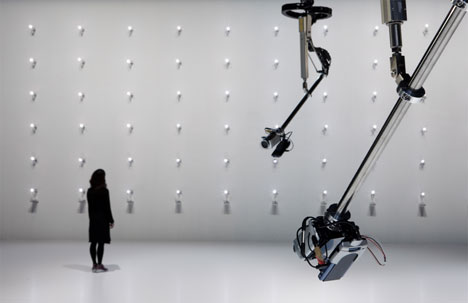
Seiko Mikami “Desire of Codes” (new work/commissioned by YCAM), photo: Ryuichi Maruo (YCAM InterLab)
Could you introduce some of your installation works that are themed on “information society and the human body” created since the 80’s?
Since the 90’s I have been making interactive interface pieces incorporating human perception, working on various projects by researching and producing from each point of senses of the complicated and broad themed ‘perception’ such as visual sense, acoustic sense, tactile sense and gravity sense.
For example, “Molecular Informatics-morphogenic substance via eye tracking” (1996) is an installation themed on visual sense, which generates morphogenic substance in the 3D space by eye tracking. Based on 2 concepts of “seeing what you see” and “chain of unconsciousness and consciousness”, it presents a dialogue environment of space and body. It also asks the audience to see itself questioning “what does it mean ‘to see what you see’.”
Another piece “gravicells” is made with the theme ‘gravity’ in collaboration with architect Sota Ichikawa, focusing attention on gravity called the 6th consciousness. With a simple interaction by standing and walking, it presents how space gets distorted with the influence of gravity. The human body captures and at the same time resists gravity by semicircular canal of the inner ear. As you get car-sick when your perception gets shaken, the relationship between gravity and the body is very deep. For supporting perception and supplementing the function of the body, we wear eyeglasses for eyes and hearing aids for ears, which will supplement the perception of gravity to support seniors, who are atrophied because of the long-term distortion of gravity, not to fall over. After exhibited at YCAM in 2004, this piece went on tour at 12 different places in 8 countries around the world. The revised version is now unveiled at YCAM.
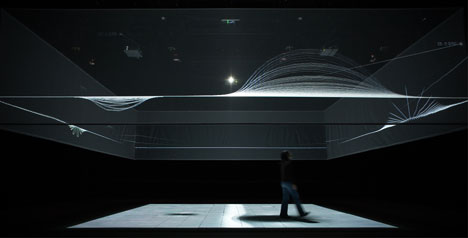
Seiko Mikami + Sota Ichikawa “gravicells – gravity and resistance” (revised version/commissioned by YCAM), photo: Ryuichi Maruo (YCAM InterLab)
Other projects are also made with the idea ‘interface exists inside the human body’. They reveal more of the process of intermedium communication of information that exists between the human body and space, rather than the piece itself as morphology. From my new work “Desire of Codes”, it may seem that the direction of my work would shift from “human body as perception” towards “individuals as informed society”. But, as my work’s theme in the 80’s was based on “information society and the human body”, it could be said that I fundamentally make works based on the same theme.
The exhibition “Desire of Codes” is composed of 3 pieces of installation. Could you discuss about the concept and each piece?
“Desire of Codes” is an interactive installation composed of 3 pieces. It reflects the current society of what I think, and presents desires growing in the society of information systems.
A large number of devices resembling tentacles with built-in small cameras are placed across a huge wall, while six robotic “search arms” equipped with cameras and projectors are suspended from the ceiling. Each device senses with insect-like wriggling movements the positions and movements of visitors, and turns toward detected persons in order to observe their actions. In addition, a giant round-shaped screen that looks like an insect’s compound eye is installed in the back of the exhibition space. Visual data transmitted from each camera, along with footage recorded by surveillance cameras installed at various places around the world, are stored in a central database, and ultimately projected in complex images mixing elements of past and present, the venue itself and points around the globe, onto the screen. The compound eye visualizes a new reality in which fragmentary aspects of space and time are recombined.
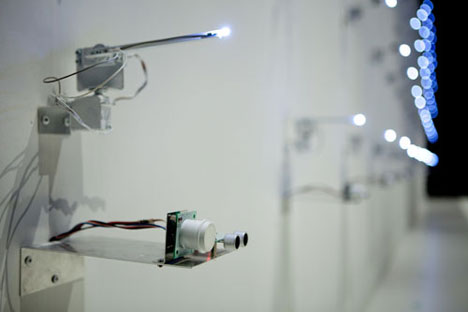
Wriggling Wall Units
Near the entrance of exhibiting space, there is a white wall with 14.4 meters in width and 4.5 meters in height, installing 90 devices of moving structures placed in 6 rows and 15 deep. Interfacing with the movement of visitors, each device wriggles as it follows the visitor, making click sounds of camera shutter that resulted in creating a rippling space of living things as a whole.
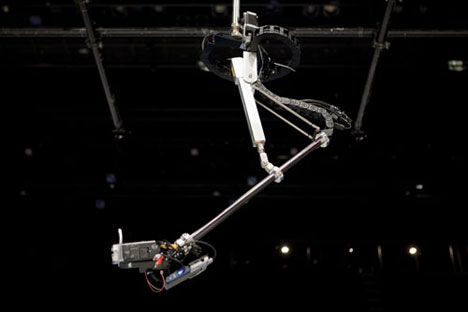
Multiperspective Search Arms
With 58 sensors placed like a spider web on the 9×6 meters ceiling in the center area, 6 robotic “search arms” resembling tentacles of an insect are suspended from the ceiling. Each arm quietly follows the movement of visitors. A micromini high-definision camera and focus-free micromini laser projector are equipped at the edge of each arm, which captures images of visitors from various angles. And these images are simultaneously projected on the floor in real time. As arms move with increasing speed, you will recognize that “current” is repetition of void.
As a visitor stands on one area, cameras zoom toward the person like a lens of video camera to focus on light. As another visitor comes close to the sensor web, the search arms start to capture and project this person quietly. Also, images of visitors recored at the entrance are also included to be projected on the floor.
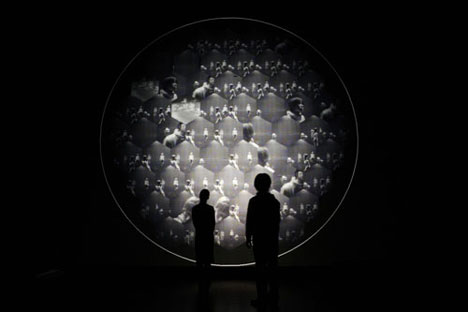
Compound Eye Detector Screen
Various independent elements of sensor, camera, and program (data), such as visual data of visitors delivered from “Wriggling Wall Units” and images collected by surveillance cameras installed in public spaces around the globe, are built as an unique database. Each insect’s compound eye works together to crossover an axis of time, space and net, to patrol in real time through the database, and all elements are segmentalized by the conception of each eye, which will be then rebuilt on the compound eye.
On the 4.7-meter diameter compound eye screen, the real-time images of the visitor’s skin, eyes or hair are projected onto single facets of the screen, where they mix with prerecorded footage of other images recorded 5 seconds, hours, days, and even weeks before, in addition to surveillance images recorded at public places around the world such as airports, parks, hallways, lakes, crowded streets, or computer rooms.
The accumulating compound eye can be considered as a device to illustrate the automatic generation of desire (data) based on information collected in contemporary information/surveillance society. The images via 61 units of eyes reminds you of looking at someone’s memory in the brain or the segmented images of dream. The database is also mounted with the face recognizing system. When it recognize a face, it automatically downloads it to the face database.
*Database
Developed for the installation “Desire of Codes”, the database is a program of monocular units to patrol various images such as online images from surveillance cameras around the world, face recognized images, past images recorded at the venue, and the real-time images. These graphically digitalized images are displayed on the monitor installed at the entrance of the exhibition space. This can be described as a manager of the program of “Desire of Codes”, which reveals the divided or intersected of the past and present.
*Sound and light integrating 3 installations
Voices and other noises generated by visitors, as well as the artworks’ own mechanical sounds are collected by superdirective microphones. From the sound, information such as sound pressure and frequency elements are picked out on the recombined time axis and analyzed. The real-time information of each installation is recorded as a database: data of angles of the movable units and reaction of each sensor arranged in 15 rows from “Wriggling Wall Units”, data of cylinder length and step monitor angle from “Search Arms”, and information appeared on display of each single eye from “Compound Eye Detector Screen”. At the same time, the behaviors and states of all of the three parts’ respective elements trigger all previously recorded sound data accumulated up to the present point, and these components keep forming a constantly updated sonic environment.
I heard it took over a year of planning the project, working with artists and engineers from various fields. Who has been involved in this project? Also, could you tell us the brief process of the project from concept to realization?
For the planning, I worked with YCAM curator Kazunao Abe, having many discussion about the project. For the actual production work, Robot Search Arms were developed by Ryota Kuwakubo, the programing of Compound Eye film was by Norimichi Hirakawa, and the programing of the wall piece was by Sota Ichikawa. Also, YYCAM InterLab staffs worked on various aspects of all the installations, design of Robot Search Arms, and sound. All of them are more artists than engineers. The fundamental idea of our common recognition “to express” resulted to enhance the quality of the pieces. And, the hardware of the wall piece is designed by Hidehumi Takegahara who also worked on the sensors and devices of “gravicells”. I got a huge support from other YCAM staffs on lighting and mechanisms, as well as documenting the progress, publicity, and documentation.
As for the production process, in the beginning, we had a plan that would be impossible to realize. We ran the first test at Tama Art University at the end of last November. As a residency project, I visited YCAM to start stay and work on it at YCAM. From March 1, I stayed at the exhibition space most of my time for its production. At the beginning, there were lots of works, tools, parts and cables all over the space. As it finished, things disappeared and the space appeared sharpen. At the last running test, what we see in the space was only the installation and its movement, feeling as if some other thing was existing, in which we finally saw its completion.
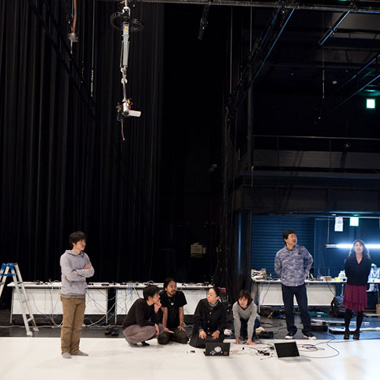
Why did you focus on the theme “information society and the human body”? Please discuss the background of Desire of Codes focused on the theme.
Desire of Codes is a “twofold existence” themed interactive installation that explores individual existence from the boundary between public and private, with the ultimate aim to highlight the increasingly blurred dividing line between “the body defined by data” and “the body of flesh and blood”.
In the information society, one can say that swirling desires keep accelerating new desires, resulting in a spirally developing twofold identity of the individual, with personal data being exposed, reflected, analyzed and updated. For example, let’s assume I buy a teddy bear book as a birthday present via the Internet. The Internet then stores my data in the category of “people who are interested in teddy bear books,” and eventually keeps sending me e-mails recommending “products that other customers who bought teddy bear books also bought” from categories that don’t interest me at all. Such “people who likes teddy bear books” eventually appear in front of me one after another, and all those data are certainly stored somewhere. Once such ”data of desires” are hammered into my mind, the fact that they are ”desires” means that they don’t disappear but rather multiply.
The user’s behavior records are visualized in graphical charts, and his behavior is still being traced in this moment. You may act to match yourself recognized by the social network. Search engines such as Google accumulate information directly out of our brains – information that we aren’t even aware of yet. At some point, the various keywords I’ve come up with and typed into search engines in order to find something I was after have perhaps transformed into a mirror of myself. Even after death, we will probably remain floating around the Internet in the form of coded skeletons of e-mail and other data.
The “double existence” is not only a matter of the Internet. For example, a look at all the data of receipts, credit and membership cards collected during yesterday’s shopping tour tells you that you bought bread at A in the morning, took a train to B, got some C at D, borrowed a video of E at F, et cetera. The sum of these data can be analyzed as a manifestation of your true self, which inspires the question whether it is your actual body of flesh and blood that defines your identity, or if you are in fact nothing but an accumulation of data. Now what if your identity card and your personal code came with their own desires as well? The problem of personal data is going to gain weight in the future, and it is not unlikely that your passports, annual income, spending, taxes, traffic violation records, hospital records, and all kinds of other personal information will be stored in one single code, as it is already the case in the “Juki Net” resident registry network. Above that, given that this will not only contain your own medical records, but coded data of the DNA that had previously determined what illnesses were to cause the deaths of your grandfathers and even earlier generations, it is possible that these codes will be analyzable to the extent that they suggest details of your future illnesses, and ultimately, your death. If codes can have desire, it could be said that it is our desire.
I made this work trying to express such reality in space, not to alert it to people.
Do you receive different feedback from audiences in Japan and overseas?
No. It may have a feature that “there’s no difference”. This is because my work so far is themed on the human basis of visual perception, hearing sense, tactile perception, and gravity. Even if few social and cultural backgrounds are different, we go through the same experiment of interaction of the human body. I exhibit my works in Europe up to 4-5 times a year, but my work has never been defined as Japanese, Asian or feminine style, and I rarely participate in an exhibition like “Japanese something Exhibition”.
What do you get inspiration from when you make works?
Based on the idea that art in a way could be a “mirror of the real society”, I guess I get inspiration from “daily life” as well. In some ways, I get sudden ideas from the top of my head. This sudden idea and my own image to the “real space” overlaps doubly, from where “a bit different another real space” will appear. These 2 images of space inevitably exists at the same time. Apart from if it’s realizable or not, to make art piece is an image of mixing the two. Sometimes, I go on a trip “to see fissures of the world” and I get inspired a lot from the natural cracks and standing at the border. But I work full-time at the university and have many things other than my projects. So I try to work on my project squeezing extra hours from the chaotic daily spiral.
What would you like to explore in the future?
I have quite many things, but realistically I will update Desire of Codes after the exhibition in Wien from August to September, adding up to 12 Search Arms and enhancing its programing parts related to the focus of the cameras. I have an idea that arms to mimic visitors’ behavior as if each arm had a brain, by complicating the trace of the movement of visitors and to adjust the timing to zoom in and out of cameras, in response to the visitor stays. During 2010 I will also work on a major update regarding the arms, to remove the sensor from the ceiling and build it into the arm itself.
During 2011, I am planning to complete the series of Desire of Codes, by making another piece to pursue the concept of “multiple view”.
I would like to realize even a little from a bunch of ideas noted in my sketchbook including an installation with hundreds of small machines looming and flying over the air, installation of hundreds and thousands of artificial plants with lighting sensors on the edge, and architectural pieces in its scale.
Seiko Mikami New installation “Desire of Codes”
Date: March 20th – June 6th, 2010
Open: 10:00 – 19:00 (Closed on Tuesdays)
Place: Yamaguchi Center for Arts and Media [YCAM]
Address: 7-7 Nakazono-cho, Yamaguchi
Tel: +81 (0)83 901 2222
Admission: Free
https://www.ycam.jp
Text: Mariko Takei




